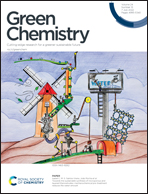Cathode recycling of lithium-ion batteries based on reusable hydrophobic eutectic solvents
Abstract
Expansion of the global market for electric vehicles has brought about a significant increase in the demand for the critical metals necessary for lithium-ion battery cathodes. Conventional cathode recycling processes can be detrimentally impactful to the environment because of the high-temperature treatment needed, and the hazardous inorganic acids and organic solvents used. Here, we demonstrate a novel cathode recycling process that employs hydrophobic eutectic solvents (HESs), which have recently attracted interest as green solvents. Our proposed process operates at mild temperatures and uses a reusable HES as an alternative to the aforementioned hazardous acids and solvents. This process consists of two simple steps, starting with direct leaching of the cathode materials by HESs typically composed of synergistic metal ligands, such as a diketone and an alkyl phosphine oxide, after which the leached critical metal ions are then separated and recovered into an aqueous oxalic acid solution. Under the optimal conditions, more than 90% of lithium, cobalt, and other critical metals was leached out from the various cathode materials, aided by ascorbic acid as the natural reducing agent. Subsequently, the metals were quantitatively recovered from the HES into the stripping solution as the cobalt oxalate precipitation and lithium-rich solution. We have succeeded in developing a potentially environmentally harmonious recycling process suitable for the sustainable production of rechargeable batteries.



 Please wait while we load your content...
Please wait while we load your content...